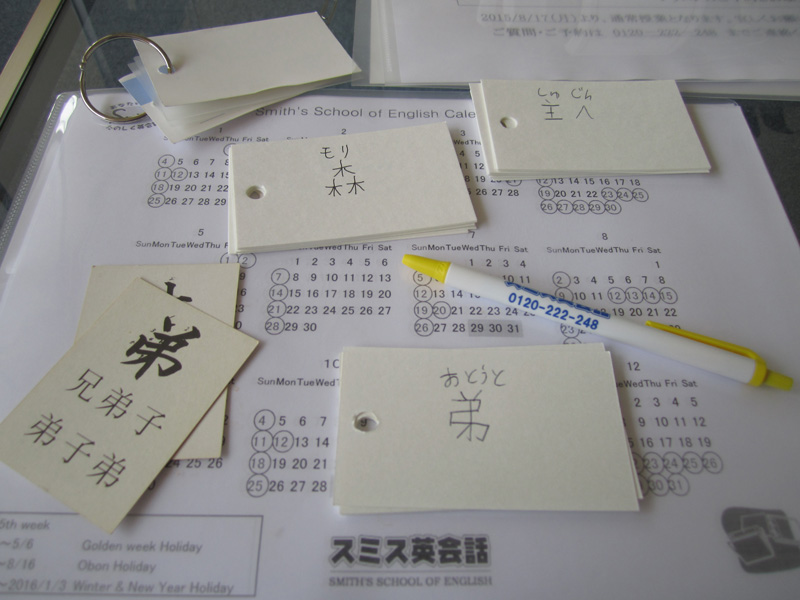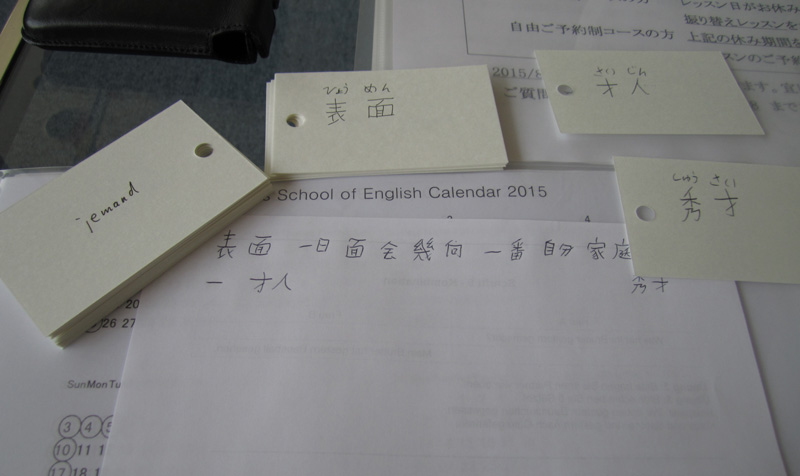 Recently, I have decided to learn to write kanji (漢字). I already can fairly read Japanese texts, but when I want to write even a small text, I could not remember the kanji, so I always had to use a computer or phone. That is why I started to study kanji again.
Recently, I have decided to learn to write kanji (漢字). I already can fairly read Japanese texts, but when I want to write even a small text, I could not remember the kanji, so I always had to use a computer or phone. That is why I started to study kanji again.
I prefer to use a card system. I learned this system in University and I have already studied words (vocabulary, 語彙) of many languages with it. It is easy and reliable, a really good system, but it needs an effort to study every day for about 20 minutes. Once a week you will need more time.
This is how I do it:
Every day, I make about 8 new cards. I choose two new kanji and also add three words that are written with that kanji (漢字). On one side of the card, I write the kanji or word and the furigana, on the other side the translation of the meaning. That takes about five minutes to do. On left bottom of the photo you can see my vocabulary cards and the popular kanji learning cards I used to study reading. Now I use them to make my vocabulary cards(単語カード).
After that I mix the new card with the old cards and put the cards on the table so that I can read them in my language (in my case German). I get a piece of scrap paper and start writing the word I in kanji and say it in Japanese. Then I take the card and check if I have made a mistake.
 It was correct! – then I put the card away on one stack. Actually, because I knew the word or kanji(漢字) immediately, I will not repeat it until Sunday. On Sunday I have time so that I can study longer. (I will repeat new words (vocabulary, 語彙) the next day!)
It was correct! – then I put the card away on one stack. Actually, because I knew the word or kanji(漢字) immediately, I will not repeat it until Sunday. On Sunday I have time so that I can study longer. (I will repeat new words (vocabulary, 語彙) the next day!)
It was wrong! – then I put the card on another stack that I will repeat immediately.
After finishing all cards, I take the stack of cards I did not know yet – the ones I made a mistake. I mix them up again and do the same all over again. Only this time I put the cards I got right on a new stack. That stack I will repeat the next day again.
After finishing all vocabulary cards(単語カード), I take the stack of cards that I did not know the second time, mix it and do it all over again – and again – and again – and again – until I could get all cards correct one time. I am finished for the day! The next day, I will start making new cards and then do it all over again!
On Sunday, I will repeat all cards. Because I am doing this for three weeks now, there are already about 250 vocabulary cards(単語カード), so I need a little more time (maybe about one hour). Words (vocabulary, 語彙) I can remember on Sunday, I will put away until the next month, so I will not have too many cards.
When I used this card system with other languages to study vocabulary (語彙), I never wrote the words, just saying them was enough. It takes even less time. With English, it may be a good idea to write the words anyways, because English spelling is so difficult.
If you need to study very quickly, it is possible to do 20 or more new vocabulary cards(単語カード) a day. Then it is a little stressful and takes more time, but it still works fine. Once you are used to the system, 10 to 15 cards a day work fine.
I like bigger cards, so I looked around till I find the cards you can see on the photos. I think that it is better to buy them at a stationary store, so you can be sure they all have the same size.
Leave a Reply